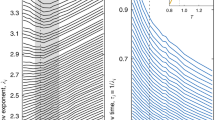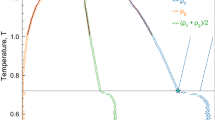Abstract
The development of a molecular theory of inhomogeneous fluids and, in particular, of the liquid–gas interface has received enormous interest in recent years; however, long-standing attempts to extend the concept of surface tension in mesoscopic approaches by making it scale dependent, although apparently plausible, have failed to connect with simulation and experimental studies of the interface that probe the detailed properties of density correlations. Here, we show that a fully microscopic theory of correlations in the interfacial region can be developed that overcomes many of the problems associated with simpler mesoscopic ideas. This theory originates from recognizing that the correlation function displays, in addition to a Goldstone mode, an unexpected hierarchy of resonances that constrain severely its structural properties. Indeed, this approach allows us to identify new classes of fully integrable models for which, surprisingly, the tension, density profile and correlation function can all be determined analytically, revealing the microscopic structure of correlations in all generalized van der Waals theories.
This is a preview of subscription content, access via your institution
Access options
Access Nature and 54 other Nature Portfolio journals
Get Nature+, our best-value online-access subscription
$29.99 / 30 days
cancel any time
Subscribe to this journal
Receive 12 print issues and online access
$209.00 per year
only $17.42 per issue
Buy this article
- Purchase on Springer Link
- Instant access to full article PDF
Prices may be subject to local taxes which are calculated during checkout




Similar content being viewed by others
Data availability
The data that support the plots within this paper and other findings of this study are available from the corresponding author upon reasonable request.
References
Zittartz, J. Microscopic approach to interfacial structure in Ising-like ferromagnets. Phys. Rev. 154, 529–534 (1967).
Wertheim, M. S. Correlations in the liquid–vapor interface. J. Chem. Phys. 65, 2377–2381 (1976).
Weeks, J. D. Structure and thermodynamics of the liquid–vapor interface.J. Chem. Phys. 67, 3106–3121 (1977).
Buff, F. P., Lovett, R. A. & Stillinger, F. H. Interfacial density profile for fluids in the critical region. Phys. Rev. Lett. 15, 621–623 (1965).
Aarts, D. G. A. L., Schmidt, M. & Lekkerkerker, H. N. W. Direct visual observation of thermal capillary waves. Science 304, 847–850 (2004).
Romero-Rochín, V., Varea, C. & Robledo, A. Microscopic expressions for interfacial bending constants and spontaneous curvature. Phys. Rev. A 44, 8417–8420 (1991).
Napiórkowski, M. & Dietrich, S. Structure of the effective Hamiltonian for liquid–vapor interfaces. Phys. Rev. E 47, 1836–1849 (1993).
Parry, A. O. & Boulter, C. J. Fluctuation theory for the wavevector expansion of the excess grand potential of a liquid–vapor interface and the theory of interfacial fluctuations. J. Phys. Condens. Matter 6, 7199–7206 (1994).
Robledo, A. & Varea, C. Interfacial width and shape fluctuations and extensions of the Gaussian model of capillary waves. J. Stat. Phys. 89, 273–282 (1997).
Mecke, K. R. & Dietrich, S. Effective Hamiltonian for liquid–vapor interfaces. Phys. Rev. E 59, 6766–6784 (1999).
Fradin, C. et al. Reduction in the surface energy of liquid interfaces at short length scales. Nature 403, 871–874 (2000).
Blokhuis, E. M., Kuipers, J. & Vink, R. L. C. Description of the fluctuating colloid–polymer interface. Phys. Rev. Lett. 101, 086101 (2008).
Blokhuis, E. M. On the spectrum of fluctuations of a liquid surface: from the molecular scale to the macroscopic scale. J. Chem. Phys. 130, 014706 (2009).
Parry, A. O., Rascón, C., Willis, G. & Evans, R. Pair correlation functions and the wavevector-dependent surface tension in a simple density functional treatment of the liquid–vapour interface. J. Phys. Condens. Matter 26, 355008 (2014).
Höfling, F. & Dietrich, S. Enhanced wavelength-dependent surface tension of liquid–vapor interfaces. Europhys. Lett. 109, 46002 (2015).
Chacón, E. & Tarazona, P. Capillary wave Hamiltonian for the Landau–Ginzburg–Wilson density functional. J. Phys. Condens. Matter 28, 244014 (2016).
Hernández-Muñoz, J., Chacón, E. & Tarazona, P. Capillary waves and the decay of density correlations at liquid surfaces. Phys. Rev. E 94, 062802 (2016).
Parry, A. O., Rascón, C. & Evans, R. The local structure factor near an interface; beyond extended capillary-wave models. J. Phys. Condens. Matter 28, 244013 (2016).
Macdowell, L. G. Capillary wave theory of adsorbed liquid films and the structure of the liquid–vapor interface. Phys. Rev. E 96, 022801 (2017).
Hernández-Muñoz, J., Chacón, E. & Tarazona, P. Capillary waves as eigenmodes of the density correlation at liquid surfaces. J. Chem. Phys. 148, 084702 (2018).
Helfrich, W. Elastic properties of lipid bilayers: theory and possible experiments. Z. Naturforsch. C 28, 693–703 (1973).
Evans, R., Henderson, J. R., Hoyle, D. C., Parry, A. O. & Sabeur, Z. A. Asymptotic decay of liquid structure: oscillatory liquid–vapour density profiles and the Fisher–Widom line. Mol. Phys. 80, 755–775 (1993).
Evans, R. The nature of the liquid–vapour interface and other topics in the statistical mechanics of non-uniform, classical fluids. Adv. Phys. 28, 143–200 (1979).
Rowlinson, J. S. & Widom, B. Molecular Theory of Capillarity (Clarendon, Oxford, 1982).
Fernández, E. M., Chacón, E., Tarazona, P., Parry, A. O. & Rascón, C. Intrinsic fluid interfaces and nonlocality. Phys. Rev. Lett. 111, 096104 (2013).
Van Campen, N. G. Condensation of a classical gas with long-range attraction. Phys. Rev. 135, 362–369 (1964).
Percus, J. K. Current problems in statistical mechanics. Trans. NY Acad. Sci. 26, 1062–1071 (1964).
Sullivan, D. E. Van der Waals model of adsorption. Phys. Rev. B 20, 3991–4000 (1979).
Sullivan, D. E. Surface tension and contact angle of a liquid–solid interface. J. Chem. Phys. 74, 2604–2615 (1981).
Pang, L. J., Landau, D. P. & Binder, K. Simulation evidence for nonlocal interface models: two correlation lengths describe complete wetting. Phys. Rev. Lett. 106, 236102 (2011).
Rosenfeld, Y. Free-energy model for the inhomogeneous hard-sphere fluid mixture and density-functional theory of freezing. Phys. Rev. Lett. 63, 980–983 (1989).
Evans, R. & Henderson, J. R. Pair correlation function decay in models of simple fluids that contain dispersion interactions. J. Phys. Condens. Matter 21, 474220 (2009).
Acknowledgements
We are grateful to F. Höfling for providing his simulation results and for discussions. A.O.P. acknowledges the EPSRC, UK, for grant EP/L020564/1 (Multiscale Analysis of Complex Interfacial Phenomena). C.R. acknowledges the support of grant FIS2015-66523-P (MINECO/FEDER, UE).
Author information
Authors and Affiliations
Contributions
A.O.P. conceived the problem and subsequent joint theoretical development. C.R. performed joint theoretical development and numerical computations.
Corresponding author
Ethics declarations
Competing interests
The authors declare no competing interests.
Additional information
Publisher’s note: Springer Nature remains neutral with regard to jurisdictional claims in published maps and institutional affiliations.
Supplementary information
Supplementary Information
1 Table, 10 References
Rights and permissions
About this article
Cite this article
Parry, A.O., Rascón, C. The Goldstone mode and resonances in the fluid interfacial region. Nat. Phys. 15, 287–292 (2019). https://doi.org/10.1038/s41567-018-0361-z
Received:
Accepted:
Published:
Issue Date:
DOI: https://doi.org/10.1038/s41567-018-0361-z
This article is cited by
-
Droplet-mediated long-range interfacial correlations. Exact field theory for entropic repulsion effects
Journal of High Energy Physics (2023)



